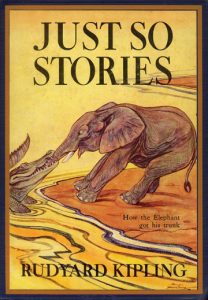Kipling Encore
Listen to the Recess! Clip
| Author | Lola Haskins |
| Air Date | 8/15/2007 |

Kipling Encore Transcript
Rudyard Kipling is much more than the author of the Jungle Book, which, no children, did NOT begin life as a cartoon. Unfortunately, most people don’t know that because his work has been downplayed for many years, not because it’s not worth remembering, but because, as an Englishman in colonial India, he happened to have been a man of his times. I’m here to make amends for that, in my opinion, unfair relegation, by speaking up for the absolute favorite of all my childhood books, the Just So Stories.
Did you know that the reason the rhino is so bad tempered is that he has cake crumbs under his skin? Or what the camel said that got him his hump? Can you tell me why the cat walks by himself? If you can, then you’ll have heard the stories, and you’ll want to hear them again. If you can’t, then you need to read this book right away. Because the Just So Stories are the kind that make you sit still for as long as they last, ,then wish they’d lasted longer. Not only that, they come with pictures. Kipling was a fantastic artist with pen and ink, and though he wasn’t primarily known for that, he was at least as good as Aubrey Beardsley. From the dense to the spare, he could make whole worlds come alive. And tell you all about them. Here’s what he said about one picture he drew:
“This is the picture of Old Man Kangaroo when he was the different animal with 4 short legs. I have drawn him grey and wooly and you can see that he is very proud because he has a wreath of flowers in his hair. He is dancing on an outcrop (that means a ledge of rock) in the middle of Australia at 6 o’clock before breakfast. The thing with the ears and the open mouth is little god Nqa. Nqa is just saying go away but the kangaroo is so busy dancing that he has not heard him yet. The Kangaroo hasn’t any real name except Boomer. He lost it because he was so proud.”
And here’s how one story begins: “In the sea, once upon a time, o my best beloved, there was a whale and he ate fishes. He ate the starfish and the garfish and the crab and the dab and the plaice and the dace and the skate and his mate and the mackerel and the pickerel and the really truly twirly-whirly eel. All the fishes he could find in all the sea he ate with his mouth-so! Till at last there was only one small fish left in all the sea and he was a small ‘stute fish and he swam a little behind the whale’s right ear so as to be out of harm’s way. Then the whale stood up on his tail and said ‘I’m hungry.’ And the small ‘stute fish said in a small ‘stute voice ‘noble and generous Cetacean, have you ever tasted man?’ ‘No’ said the whale. ‘What’s it like?’ Nice’ said the small ‘stute fish. ‘Nice but nubbly.’
But don’t take my word for it, “best beloved,” find out for yourself just how “nubbly” and “stute” the Just So Stories are. And if what you’ve just heard doesn’t make you want to run right out and get your own copy of the Just So Stories, then you’re missing out but have a nice day anyway. For Recess!, I’m Lola Haskins.
Explore This Topic Further
Books
[supsystic-gallery id=21]
Further Reading